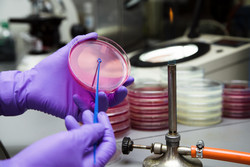Novel toxicology detectors on paper
The incidence of antibiotic resistance is advancing at an alarming pace. Though effective, antibiotics impose great selective pressure on bacteria, resulting in mutations mainly in antibiotic resistance genes or drug resistance pumps, allowing bacteria to survive. Consequently, new strategies for antibiotics design are required. Recent advances in drug delivery systems utilise nanoparticle-based carriers. These constitute novel antibiotics but can also be used to answer fundamental questions about bacterial biology. Pharmacological and toxicological studies of most drug carriers are conducted on coarse bacterial populations and only generate information about the bacterial median survival. Seeking to overcome the limitations of current methods, the EU-funded NANOTESTS (Fabrication and development of nanotoxicology-test bacterial arrays for the investigation of antibiotics against multi drug-resistant bacteria) project set out to miniaturise diagnostic tools and develop toxicological assays on single microbes. The design of the generated point-of-care diagnostic device relied on the principles of materials science and surface chemistry. More specifically, NANOTESTS researchers constructed a microfluidic device made of paper and optimised the surface chemistry to render the paper suitable for toxicological studies. Next, they created microfluidic channels on the surface of the paper to test the toxicological effect of different chemicals. This inexpensive NANOTESTS platform has the potential to control biomedical fluid handling and is easy to use even by less experienced personnel in developing countries. Most importantly, the microfluidic-based instrument can simultaneously provide information on the toxicological impact of multiple drugs and chemicals on single bacteria. Using this system to evaluate the outcome of nanoparticle-based drug carriers could produce robust solutions against antibiotic-resistant pathogens.







